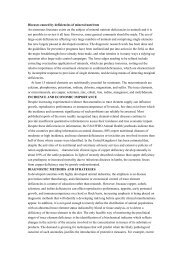Technological and Technical Development of Tobacco Drying
Technological and Technical Development of Tobacco Drying
Technological and Technical Development of Tobacco Drying
Create successful ePaper yourself
Turn your PDF publications into a flip-book with our unique Google optimized e-Paper software.
'There is another disadvantage, that the existing curing barns can only be used in a short period <strong>of</strong> the<br />
year, so the utilization rate is bad. Generally we can say, that the surplus expenditures is not realized in<br />
the quality <strong>of</strong> the cured tobacco <strong>and</strong> income.<br />
Our purpose has been to develop a new method <strong>and</strong> equipment, which eliminates the above detailed<br />
disadvantages <strong>and</strong> results some forwarding solutions.<br />
It has been verified experimentally, that if the tobacco leaves are hanged up in racks as usually <strong>and</strong> the<br />
curing air is circled evenly from above to downwards, then the laminas <strong>of</strong> the leaves are bowled as a flag<br />
in the direction <strong>of</strong> the circulation. It is such a surplus effect, which assures a lower resistance <strong>and</strong> uniform<br />
air-ventilation in the curing chamber. In this case the energy dem<strong>and</strong> <strong>of</strong> the ventilation is less, than the<br />
same volume curing air circulated upwards from below.<br />
It can be guaranteed a constant intensity air movement in the whole cross-section <strong>of</strong> the barn by the<br />
evaporating air, forced in the direction <strong>of</strong> the gravitation. It is a condition <strong>of</strong> the uniform <strong>and</strong><br />
homogeneous drying(Figure 5.).<br />
The heated air is circulated from above to downwards, touches the upper part <strong>of</strong> the high water content<br />
midrib at first, so the too early drying out <strong>of</strong> the lamina can be avoid. It was a surplus recognition,<br />
because this solution can assure favorable heat-effect for the whole leaves. On the other h<strong>and</strong>, the<br />
protected leaf lamina has a smaller heat-load <strong>and</strong> it has a chance to maintain an optimum respiration<br />
process, during the yellowing <strong>and</strong> color fixing.<br />
The uniform air-distribution <strong>and</strong> the homogeneous curing render a precise temperature <strong>and</strong> relative<br />
humidity monitoring <strong>and</strong> control in the barn.<br />
It is also a condition <strong>of</strong> reaching the best color <strong>and</strong> chemical components for the end <strong>of</strong> the schedule<br />
(Kerekes – Lengyel, 1998).<br />
It can also be reached the same similarity, when the tobacco is humidified, after finishing the process. We<br />
can avoid the uneven moistening, which causes spots on the surface <strong>of</strong> the leaf.<br />
Another new recognition, that an overshadowing screen can solve the recovering <strong>of</strong> the radiated heat-loss.<br />
It means, that the heat - which radiated out from the wall <strong>of</strong> the barn - is gathered by a special screen, so<br />
the air-space between the chamber <strong>and</strong> the screen is used as recuperator, which pre - heats the exterior air,<br />
drawing in for curing.<br />
Moreover, we recognized, that if we established a light - permeable cover over the heat - screen, we<br />
would produce such a heat-trap, which could utilize the energy <strong>of</strong> the sun. This simple sun - collector<br />
would pre-heat the entered curing air.<br />
Finally, it was a new idea, that when the curing barn was out <strong>of</strong> the basic function, the transparent cover<br />
could be moved back on rails, so the system could work as a greenhouse, running by the thermo generator<br />
<strong>of</strong> the barn. This multi-purpose utilization guaranteed a more economical work.<br />
In our region most <strong>of</strong> the curing barn can reconstruct for drying <strong>of</strong> fruits or vegetables.<br />
In the Figure 6. you can study the setting up <strong>of</strong> the multi-purpose curing barn.<br />
In Hungary many smaller tobacco curing barn were developed in the past ten years, according to the<br />
requirements <strong>of</strong> the tobacco growers <strong>and</strong> the processing enterprises.<br />
When starting production <strong>of</strong> the Virginia type tobacco, the cooperatives used mainly the big capacity<br />
"SIROKKÓ"-type barns. Most <strong>of</strong> these equipments were working continuously after the privatization, but<br />
they consumed too much energy <strong>and</strong> they were not able to produce a high quality dried tobacco.<br />
'They must be renewed <strong>and</strong> reconstructed in the near future.<br />
We have made an extended experimental <strong>and</strong> practical examination, regarding to the stated new<br />
development (Kerekes – Lengyel – Sikolya, 1997).















